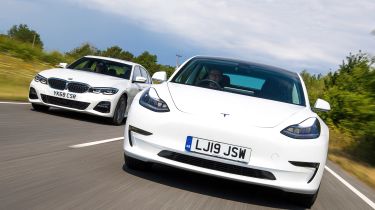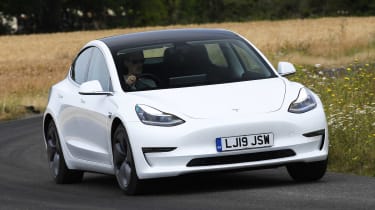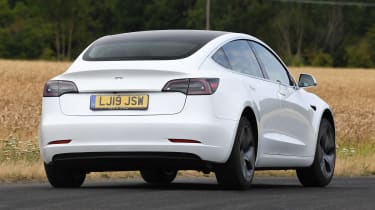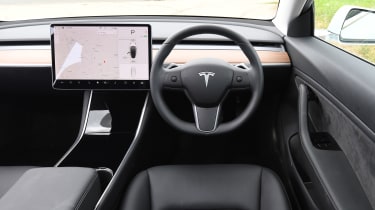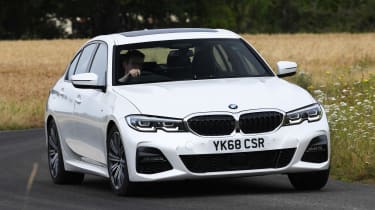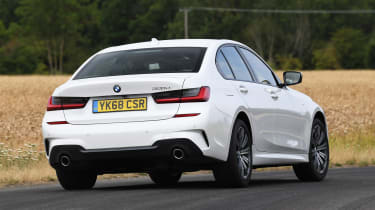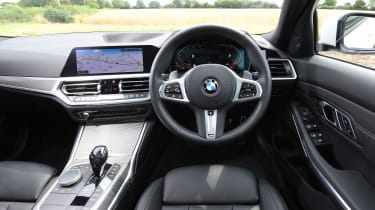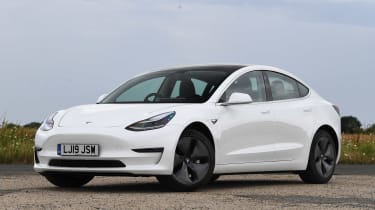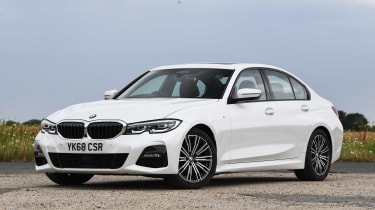Tesla Model 3 vs BMW 3 Series: electric car vs diesel showdown
The new Tesla Model 3 is ruffling feathers in the junior exec class. We put the electric saloon up against the class-leading BMW 3 Series
Have we reached the point where you’re better off buying an electric car than a conventionally powered alternative? That’s the question we’re aiming to answer by examining every area of these two titans in this Auto Express twin test.
The Tesla Model 3 has been hotly anticipated – and now it’s finally here in right-hand-drive form. There has also been a cut to the car’s list price to coincide with the start of deliveries in the UK, so the Model 3 Standard Range Plus we’re testing here now costs from £36,490.
That puts the American EV straight in the firing line of what is possibly the iconic junior executive saloon of the past two decades: the BMW 320d. When it comes to conventionally powered machinery, this is the class leader and therefore the one that the Model 3 has to overcome.
Even Tesla’s own boss, Elon Musk, said the Model 3 would take on and beat BMW’s best when it launched, so these two models are a closer comparison than you might think, despite their different methods of propulsion. But is the time right to go all-electric in a car like this? Let’s find out.
Tesla Model 3
| Model: | Tesla Model 3 Standard Range Plus |
| Price: | £36,490 |
| Engine: | Single electric motor, 235bhp |
| 0-60mph: | 5.8 seconds |
| Test economy: | 4.3 miles/kWh |
| CO2: | 0g/km |
| Annual road tax: | £0 |
A recent price cut to this entry-level Model 3 – the Standard Range Plus – means it’s now more affordable than ever, costing £36,490 after the £3,500 Government grant for electric cars. That’s £1,835 cheaper than the BMW 3 Series here, so the two models are relatively close when it comes to price and spec.
Design & engineering
The Model 3’s platform is similar to the concept used for Tesla’s larger Model S and Model X EVs, with a steel skateboard’-type chassis that also features some aluminium to help reduce weight. Tesla chose that style of architecture in order to sandwich the Model 3’s 55kWh battery in the car’s floor, so the majority of its 1,611kg is low down. This should help handling and ensure it doesn’t impact the packaging too much.
Used - available now

2021 Tesla
Model 3
60,834 milesAutomaticElectric
Cash £15,035
2021 Tesla
Model 3
24,873 milesAutomaticElectric
Cash £18,197
2023 Tesla
Model 3
51,247 milesAutomaticElectric
Cash £17,983
2023 Tesla
Model 3
32,300 milesAutomaticElectric
Cash £20,056The Standard Range Plus claims 254 miles between charges from its 55kWh battery (50kWh usable). There’s one electric motor at the rear delivering 235bhp and 375Nm of torque, which is plenty in a car this size and weight. While it’s heavier than the 320d, it also outguns it quite considerably for output.
Although the Model 3 is compatible with Tesla Superchargers, it’s also the brand’s first model to accept CCS rapid charging, which improves usability by opening the car up to many more charging points. With infrastructure improving and points with up to 150kW being installed in the UK, this helps practicality.
This entry-level Model 3 comes well equipped, with a centrally mounted 15-inch touchscreen that controls all of the car’s functions. There’s no other screen inside the cabin, which gives it a very clean and uncluttered design, but we’d like a head-up display in front of the driver for vital information.
Sat-nav, heated electrically adjustable seats, LED lights, climate and adaptive cruise control, autonomous braking with collision warning, and the marque’s semi-autonomous Autopilot system are included.
It’s fair to say cabin quality hasn’t always been a Tesla strong point, especially when compared with established makers like BMW, but there’s a noticeable step up here in the quality over the firm’s earlier efforts. Yet there are still some areas of iffy build standards, particularly around the two central storage bins.
Driving
Compared with a combustion-engined car, you have to recalibrate your brain and driving style to get the most from an EV. There are two modes for the Tesla’s throttle response: Chill and Standard. In the first of these acceleration is progressive and torque builds smoothly, so it’s relaxing, with plenty of performance in reserve. In Standard the response is much sharper, with huge torque seemingly delivered instantly. It makes the car feel much more alert, and in this setting the 3 is rapid. It sprinted from 0-60mph in 5.8 seconds, 0.8 seconds quicker than the 320d.
With no gearchanges because of the single-speed automatic set-up, progress is smooth and acceleration very strong at low and mid speeds, as our figures from 30-50mph and 50-70mph show. However it loses its edge a little at higher speeds.
It’s not as communicative as the BMW, but there’s plenty of ability. With all that weight low down, the Model 3 grips hard, because particular attention was paid to development of the EV-specific tyres and suspension design to get the car to cling on, despite the battery’s mass.
You don’t get much of a sensation as to how much grip there is, but you can make the car even more agile by adjusting the steering modes; there’s Comfort, Standard and Sport, which ramp up weight and speed so the 3 changes direction more aggressively.
The regenerative braking is good, too, slowing the car at a predictable rate and recouping energy to increase potential range. It has on and off modes, but we’d leave it on, because it allows the one-pedal driving that has come define the EV experience.
While the car rides relatively well on its 18-inch alloys, it can feel a little less forgiving than we’d like on bumpier surfaces, but it settles down at higher speed.
Practicality
Charging is a big issue for EVs, but the Model 3 is flexible. Supercharger use costs 24p per kWh (you get 400kWh free every year) to add around 170 miles of range in 30 minutes.
But it’s the first Tesla to accept CCS rapid charging. A 50kW feed will take just under 50 minutes to give an 80 per cent top-up, while a 100kW charge drops the time to around 25 minutes. A 7.4kW wallbox feed means a full overnight charge at home takes around eight hours, adding to the car’s flexibility.
Ownership
The Model 3 scored the highest ever safety assist rating at 94 per cent, under Euro NCAP’s latest regime, helping it to receive a full five-star rating, along with autonomous emergency braking, adaptive cruise and Autopilot.
Tesla topped our Driver Power 2016 satisfaction poll, but hasn’t ranked since. With lots of tech shared with other Teslas, the Model 3 should be reliable.
Running costs
Your energy costs for an average year’s motoring (12,000 miles) will depend on how much you use public charging points.
Signed up to a home electricity tariff of 12.5p per kWh, you’ll spend roughly £350 on electricity a year, or just under 3p per mile. That’s cheap motoring, even compared with the frugal 320d. It’s unlikely this figure will go much beyond £500, even with public charging.
Given the Model 3’s zero emissions, it attracts the lowest 16 per cent Benefit-in-Kind company car tax. It’s cheaper than the BMW too, so will cost high-rate earners £2,332 per year, compared with £4,567 per annum for the 320d, due to its 30 per cent BiK rate.
Testers’ notes: “Over-the-air updates can unlock extra features throughout the car’s lifetime, so it’s possible that your Model 3 could improve as it ages; not many conventional cars can claim that.”
BMW 3 Series
| Model: | BMW 320d M Sport Sport Auto |
| Price: | £38,325 |
| Engine: | 2.0-litre 4cyl diesel, 187bhp |
| 0-60mph: | 6.6 seconds |
| Test economy: | 53.3mpg/11.7mpl |
| CO2: | 113g/km |
| Annual road tax: | £145 |
For decades the diesel compact executive saloon has been the go-to choice for those wanting to balance luxury, decent performance and handling, cruising refinement, technology, plus practicality – but is that still the case today? We test the £38,325 320d M Sport to find out.
Design & engineering
This seventh-generation 3 Series is now competing with electric cars, highlighting just how far tech has moved on. The BMW has kept pace, though, with an all-new platform underneath here, the latest infotainment, engine revisions and some clever suspension tech.
That architecture is based on BMW’s CLAR platform. As in the Tesla, four-wheel drive is available, but you don’t have to opt for a performance version to get it.
Engine tweaks over its predecessor improve the 3 Series’ refinement and response. The set-up includes a small turbocharger for better response and a larger one to boost power at higher revs.
The 2.0-litre four-cylinder turbodiesel produces 187bhp and 400Nm of torque, and is linked to an eight-speed automatic gearbox, so the recipe is relatively conventional compared with the Tesla’s.
Its new dampers employ ‘lift dependent technology,’ which means when the car is unloaded, light and therefore doesn’t sit too far through the suspension’s stroke, the damping forces are lighter. When the BMW is loaded and heavier, sitting lower, the damping is tauter to improve body control.
M Sport trim comes with parking sensors, a reversing camera, autonomous braking, climate, cruise, heated leather seats and a digital dash, so it matches the Model 3’s kit. It adds Apple CarPlay, too.
BMW’s semi-autonomous driving system is extra, but it exceeds the Tesla for quality. The materials are superior, and the 3 Series’ cabin feels better built. Yet these cars must cover so many bases that this isn’t the full story, and one of those is how they drive.
Driving
Here the 3 Series delivers. It’s not quite as quick as the Tesla to 60mph, because it took 6.6 seconds, but given it’s down on power and torque, and has gearchanges that punctuate acceleration, that’s a good result.
Our flexibility tests aren’t directly comparable due to the difference in transmissions. In the Tesla you simply plant your foot and go, making it extremely easy to drive, but in the BMW it’s not so swift.
The German car’s box is one of the best automatic transmissions on sale, though, and responds well to inputs from the accelerator, kicking down swiftly and shifting up smoothly. Pick manual mode, leave it in gear and the 3 Series delivers as much flexibility and easy pulling power as you’d need from an ICE car.
The BMW’s engine is refined, too, only grumbling loudly at higher revs. But its noise is ever-present, unlike in the Tesla, with its near-silent e-motor.
It handles better than the Model 3, though, feeling grippier and less artificial when it comes to its agility. The steering has a much nicer weight, has more feel than the Tesla’s (you’d think it had none if you hadn’t driven a Model 3 before) and the chassis feeds back clearer messages of what’s going on at the interface between the road surface and the tyres. The ride is good, but isn’t without its issues. It’s more forgiving, but not by too much compared with the Tesla’s. Still, the ride is just that little bit more abrupt than we’d like.
With some extra weight it settles down, but the quality of the damping feels plush where the Model 3 is a little more staccato in its suspension movement. There’s enough comfort, refinement, handling ability and performance, it’s just delivered in a different way to the Tesla – subtly in some areas, markedly in others.
Practicality
The 3 Series is bound by packaging constraints that the Model 3 isn’t, such as its engine and transmission tunnel, but the BMW actually offers slightly more rear legroom and even more headroom. It’s not quite as roomy in the front, though. The 320d’s architecture means the dash and centre console are bigger and bulkier, with more buttons to control the climate and infotainment.
While it doesn’t have a load area in the front like the Tesla, its 480-litre boot means there’s more luggage volume than in the Model 3, which offers 425 litres, while the BMW’s boot opening is larger and therefore more practical as well.
Ownership
BMW finished 21st in our Driver Power 2019 satisfaction survey, which was a fairly low result for the premium brand. However, the previous 3 Series was voted the 38th best car to live with by Auto Express readers, and much of the tech in the new car is evolutionary and has already proved reliable elsewhere in the BMW range.
Safety is strong, with AEB, collision warning and lane-departure alert standard in M Sport trim. Our car also had the £1,250 Driving Assistant Professional pack, which adds adaptive cruise, cross-traffic warning, lane-keep assist with side collision prevention, and a semi-autonomous drive function that’ll keep you in a lane like the Tesla. It works as well as in the Model 3.
Running costs
Our fleet 320d test car featured in this head to head, and it’s currently returning 53.3mpg. This is impressively efficient, but will still cost £1,322 a year to fuel, which equates to 11p per mile, nearly four times the cost of the Tesla.
It also won’t hold its money quite as well, with our experts predicting the BMW will retain 44.8 per cent, or £17,173, a loss of £21,152. EVs are becoming more popular, and predicted residual values reflect this; the Model 3 is expected to hold on to a very impressive 68.7 per cent after three years or 36,000 miles. It’ll be worth £25,061 after this period, losing just £11,429.
Testers’ notes: “BMW has refined its infotainment to the point where it’s one of the best. We’d do without the gesture control on our car, but it’s easily a match for the Tesla and better in some cases.”
Verdict
First place: Tesla Model 3
This result is close, but the Model 3 proves that now is the time you can buy an EV instead of an ICE car. It takes victory thanks to its ultra-low running costs, while comfort, tech and practicality are on par with the BMW’s, yet performance is better. There is a caveat: around 12,000 miles a year is viable with this level of range, so if you can put up with some public charging (most people will top up overnight), it’s a great option.
Second place: BMW 3 Series
The 3 Series is still a fine compact executive saloon with all the attributes we value in a car in this class. It’s comfortable enough, fast enough, frugal, superbly practical, great to drive and offers lots of technology – but so does the Tesla, and it’s also much cheaper to run. If you cover long distances regularly then the flexibility a diesel offers might mean the BMW is a better bet.
Other options in this category...
Kia e-Niro
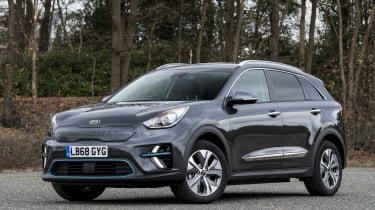
Model: Kia e-Niro First EditionPrice: £32,995Engine: 1x electric motor, 201bhp
It’s not as quick nor as premium as the Model 3, but range is key to an electric car and the e-Niro’s claimed 282-mile distance between top-ups is accurate. First Edition models get loads of kit, too. The biggest single problem is the waiting list.
Jaguar XE
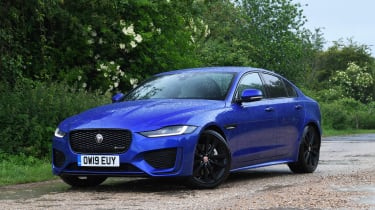
Model: Jaguar XE D180 R-Dynamic SEPrice: £37,615Engine: 2.0-litre 4cyl, 178bhp
If an EV still isn’t for you, the newly updated Jaguar XE is as dynamic and involving as the BMW. R-Dynamic adds sporty looks, while SE trim gets a digital dash, new infotainment, good safety tech and strong connectivity. D180 engine is all you’ll need.
Figures
| Tesla Model 3 Standard Range Plus | BMW 320d M Sport Sport Auto | |
| On the road price/total as tested | £36,490/£36,490 | £38,325/£45,505 |
| Residual value (after 3yrs/36,000) | £25,061/68.7% | £17,173/44.8% |
| Depreciation | £11,429 | £21,152 |
| Annual tax liability std/higher rate | £1,166/£2,332 | £2,284/£4,567 |
| Annual fuel cost (12k/20k miles) | £349/£698 | £1,322/£2,204 |
| Insurance group/quote/VED | N/A/£625/£0 | 29/£562/£165 |
| Cost of servicing | N/A | £25 per month (3yrs) |
| Length/wheelbase | 4,694/2,875mm | 4,709/2,851mm |
| Height/width | 1,443/1,849mm | 1,442/1,827mm |
| Engine | 1x electric motor | 4cyl in-line/1,995cc |
| Peak power/revs | 235 bhp/N/A rpm | 187/4,000 bhp/rpm |
| Peak torque/revs | 375Nm/N/A rpm | 400/1,750 Nm/rpm |
| Transmission | Single-spd auto/rwd | 8-speed auto/rwd |
| Battery size (usable/actual)/tank capacity | 50/55kWh | 59 litres |
| Boot capacity | 425 litres | 480 litres |
| Kerbweight/payload/towing weight | 1,611/418/910kg | 1,450/610/1,600kg |
| Turning circle | 11.8 metres | 11.4 metres |
| Basic warranty (miles)/recovery | 8yrs (100,000)/8yrs | 3yrs (60,000)/3yrs |
| Driver Power manufacturer/dealer pos. | N/A/N/A | 21st/19th |
| NCAP: Adult/child/ped./assist/stars | 96/86/74/94/5 | N/A |
| 0-60/30-70mph | 5.8/4.5 secs | 6.6/6.0 secs |
| 30-50mph in 3rd/4th | 1.9 secs | 2.7/3.0 secs |
| 50-70mph in 5th/6th/7th/8th | 2.6 secs | 4.3/5.9/7.4/13.4 secs |
| Top speed/rpm at 70mph | 140mph/N/A | 149mph/1,600rpm |
| Braking 70-0/60-0/30-0mph | 47.9/35.5/8.8m | 44.5/32.2/9.6m |
| Noise outside/idle/30/70mph | N/A/N/A/64/72dB | 70/44/60/70dB |
| Auto Express economy/range (miles) | 4.3 miles/kWh/217 | 53.3mpg/11.7mpl/692 |
| Claimed range/fuel economy (WLTP) | 254 miles | 52.3-54.3 |
| Actual/claimed CO2/tax bracket | 0/0g/km/16% | 142/113g/km/30% |
| Airbags/Isofix/park sensors/camera | Eight/yes/yes/yes | Eight/yes/yes/yes |
| Auto box/lane-keep/blind spot/AEB | Yes/yes/yes/yes | Y/£1,250*/£1,250*/y |
| Clim./cruise ctrl/leather/heated seats | Yes/yes/yes/yes | Yes/yes/yes/yes |
| Met paint/LEDs/keyless/pwr tailgate | Yes/yes/yes/no | £670/y/£990*/£990* |
| Nav/digi dash/DAB/connected services | Yes/yes/yes/yes | Yes/yes/yes/yes |
| Wireless charge/CarPlay/Android Auto | No/no/no | £350/yes/no |
